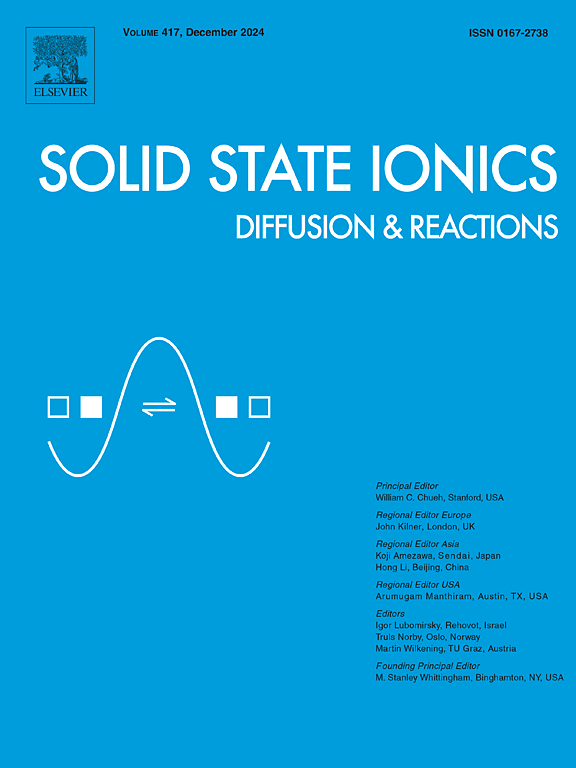Excellent stability of layered Na0.67Ni0.33Fe0.33Mn0.33O2 cathode materials with P2/O3 biphasic system in humid ambient air
IF 3
4区 材料科学
Q3 CHEMISTRY, PHYSICAL
引用次数: 0
Abstract
Sodium ion batteries (SIBs) have shown broad application prospects in the field of energy storage due to their low cost, high safety, wide operating temperature range, fast charging, and environmental friendliness. As one of the key components of SIBs, layered oxide cathodes have significant advantages such as high specific capacity, feasible energy density, and high operating voltage, but they also face challenges of poor interface stability and insufficient air stability. In this work, a P2/O3 biphasic system Na0.67Ni0.33Fe0.33Mn0.33O2 (Na0.67NFM) is synthesized by a sol-gel and subsequent solid phase calcination method. Furthermore, the structural characteristics of Na0.67NFM calcined at 900 °C (Na0.67NFM-900) are investigated, revealing that it maintains a high stability even after exposure in humid ambient air for 5 days. Although a small amount of Na2CO3 and NaHCO3 is produced on the surface of Na0.67NFM-900, the main P2/O3 structure still maintains overall integrity into the internal bulk phase. Therefore, the electrochemical performance of Na0.67NFM cathode is not significantly affected after short-term air exposure. After 200 cycles at 1C, the capacity retention of Na0.67NFM-900 cathode still remains 72.3 %, which is almost comparable to that of the unexposed one (75.7 %). This work indicates that Na0.67NFM is a promising candidate cathode material with exceptional air stability for SIBs.

P2/O3双相体系层状Na0.67Ni0.33Fe0.33Mn0.33O2正极材料在潮湿环境空气中的优异稳定性
钠离子电池具有成本低、安全性高、工作温度范围宽、充电速度快、环境友好等优点,在储能领域具有广阔的应用前景。层状氧化物阴极作为sib的关键部件之一,具有高比容量、可行能量密度和高工作电压等显著优势,但也面临界面稳定性差和空气稳定性不足的挑战。本文采用溶胶-凝胶法和固相煅烧法合成了P2/O3双相体系Na0.67Ni0.33Fe0.33Mn0.33O2 (Na0.67NFM)。此外,研究了900°C下煅烧的Na0.67NFM (Na0.67NFM-900)的结构特征,发现即使在潮湿的环境空气中暴露5天后,它仍能保持较高的稳定性。虽然在Na0.67NFM-900表面产生了少量的Na2CO3和NaHCO3,但主要的P2/O3结构仍保持整体完整进入内部体相。因此,短期暴露在空气中对Na0.67NFM阴极的电化学性能没有明显影响。在1C下循环200次后,Na0.67NFM-900阴极的容量保持率仍为72.3%,几乎与未暴露的阳极(75.7%)相当。这项工作表明,Na0.67NFM是一种有前途的候选阴极材料,具有优异的空气稳定性。
本文章由计算机程序翻译,如有差异,请以英文原文为准。
求助全文
约1分钟内获得全文
求助全文
来源期刊

Solid State Ionics
物理-物理:凝聚态物理
CiteScore
6.10
自引率
3.10%
发文量
152
审稿时长
58 days
期刊介绍:
This interdisciplinary journal is devoted to the physics, chemistry and materials science of diffusion, mass transport, and reactivity of solids. The major part of each issue is devoted to articles on:
(i) physics and chemistry of defects in solids;
(ii) reactions in and on solids, e.g. intercalation, corrosion, oxidation, sintering;
(iii) ion transport measurements, mechanisms and theory;
(iv) solid state electrochemistry;
(v) ionically-electronically mixed conducting solids.
Related technological applications are also included, provided their characteristics are interpreted in terms of the basic solid state properties.
Review papers and relevant symposium proceedings are welcome.
 求助内容:
求助内容: 应助结果提醒方式:
应助结果提醒方式:


